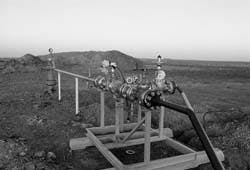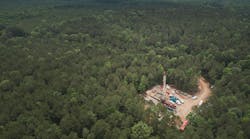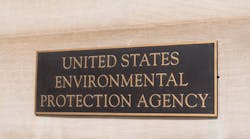The water-alternating-gas wellhead skid includes a spectacle blind, a wedge meter, and a choke.
The Postle field carbon dioxide flood marks the first time anyone in the industry has attempted a major CO2 enhanced oil recovery EOR project at such a late stage in a waterflooded field, according to Mobil Exploration & Producing U.S. Inc. Prior to CO2 injection Postle produced oil with a 98% water cut.
Mobil began injecting CO2 into the Postle on Nov. 15, 1995.
The Postle field, discovered in 1958 in the Oklahoma Panhandle near Guymon, had produced about 92 million bbl of oil under primary and waterflood production. Waterflooding started in 1967.
Oil production peaked at about 22,000 bo/d in 1970 and averaged about 2,000 bo/d when CO2 injection began at a rate of 35 MMscfd.
Plans
Most CO2 projects begin a lot sooner, usually at the 60-70% water cut; therefore, Mobil says it was concerned that it might be too late for CO2 injection. However, Mobil says, this project is proving that if you manage your reservoir carefully and do your investing right, it can work.
Mobil expects the production rate to increase to 2,300 bo/d in 1996 and peak at about 10,000 bo/d by 2000. Field life will be extended another 15 years. Typically an additional 10-14% of the original oil in place is expected to be recovered with CO2 injection.
A good candidate field for CO2 injection must meet certain criteria. Good recovery from a waterflood, for example, means good CO2 potential, says Mobil. Other considerations include the reservoir structure, pressure, temperature, and viscosity of the oil.
Although basic CO2 technology has not changed significantly over the years, Mobil says a greater focus is being placed on improving the efficiency of the injection design schemes. It is an ongoing process in which you learn from the reservoir and make adjustments to maximize recovery.
The technology of putting CO2 in the ground is the same, but how you monitor and control it is where the process continues to be refined, according to Mobil. Mobil says its reservoir surveillance technology is the most advanced in the industry.
CO2 process
Mobil will use a water-alternating-gas (WAG) process. When CO2 is injected into a well, it travels into the reservoir and mixes with the oil, making the oil lighter and easier to move. After a period of 1-3 months, CO2 injection in an individual well is stopped and water injection resumes.
The water pushes the lighter oil toward adjacent producing well bores. The CO2-laden oil is pumped to the surface and piped to a central tank battery, where the oil, water, and associated gas are separated.
The water goes to an injection facility for reinjection, the oil is sold to a pipeline, and the associated gas is piped to a treatment plant. The plant removes natural gas liquids from the gas stream and separates the natural gas from the CO2.
The recovered NGLs are sold, and the CO2 is compressed and returned to the injection facility for reinjection. The WAG process continues for a period of years until it is stopped and waterflooding begins anew.
Project installations
CO2 injection began in the Postle field a scant 10 months after funding the project, primarily because of best-practices sharing with the company's other CO2 fields, according to Mobil. Mobil used the best of its experience in areas such as metallurgy, evolution of measurement systems, and satellite production systems, to avoid having to reinvent the wheel.
Mobil says by leaning heavily on field experience, nearly a year's worth of engineering time was eliminated.
One element of the project was the construction of a $25 million, 120-mile pipeline to carry Mobil's CO2 to the Postle field. The pipeline includes extra capacity available for other projects. Mobil contracted with third party, Transpetco Transport Co., a CO2 transporter since 1969, to build and operate the pipeline.
Mobil also contracted Williams Field Services to build a $35 million treatment plant, which will be completed in December 1996.
The Postle field project is being implemented in two phases. The current Phase 1 encompasses two units of the field. CO2 is being injected into 60 wells, both new and converted, at a depth of 6,150 ft.
Phase 2, scheduled to begin in 1997, will add two units with 60 additional wells. CO2 injection throughout the field will continue for about 7 years.
Mobil says things learned from Phase 1 will aid in implementation of Phase 2. Mobil expects the WAG skids to be simpler, and more of the facilities' work will be completed before the well work, rather than kicking both off simultaneously, as in Phase 1.
Another best practice being implemented is better scheduling of capital outlays to when needed, according to Mobil. Mobil describes the process as similar to the "just in time" inventory practices in the manufacturing business. For instance, the CO2 reprocessing facilities are timed to be functional when the CO2-laden oil is forecasted to be produced, about a year after the CO2 injection began.
Mobil's experience
Mobil has operated CO2 EOR projects for the last 14 years. Its first was a small project in 1982 in the West Texas GMK field, which currently produces about 1,200 bo/d. Other West Texas projects include, the Mahoney lease of the Wasson field, producing 2,100 bo/d, the Salt Creek field, producing 26,500 bo/d, and three separate projects in the Slaughter field that produce a combined total of 5,800 bo/d.
In the Four Corners area of Utah, Mobil is using CO2 injection to produce about 6,200 bo/d from the McElmo Creek field.
Copyright 1996 Oil & Gas Journal. All Rights Reserved.


